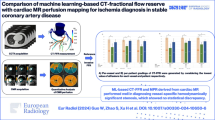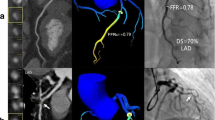Abstract
To explore the diagnostic performance of a machine-learning-based (ML-based) computed fractional flow reserve (cFFR) derived from coronary computed tomography angiography (CCTA) in identifying ischemia-causing lesions verified by invasive FFR in catheter coronary angiography (ICA). We retrospectively studied 117 intermediate coronary artery lesions [40–80% diameter stenosis (DS)] from 105 patients (mean age 62 years, 32 female) who had undergone invasive FFR. CCTA images were used to compute cFFR values on the workstation. DS and the myocardium jeopardy index (MJI) of coronary stenosis were also assessed with CCTA. The diagnostic performance of cFFR was evaluated, including its correlation with invasive FFR and its diagnostic accuracy. Then, its performance was compared to that of combined DS and MJI. Of the 117 lesions, 36 (30.8%) had invasive FFR ≤ 0.80; 22 cFFR were measured as true positives and 74 cFFR as true negatives. The average time of cFFR assessment was 18 ± 7 min. The cFFR correlated strongly to invasive FFR (Spearman’s coefficient 0.665, p < 0.01). When diagnosing invasive FFR ≤ 0.80, the accuracy of cFFR was 82% with an AUC of 0.864, which was significantly higher than that of DS (accuracy 75%, AUC 0.777, p = 0.013). The AUC of cFFR was not significantly different from that of combined DS and MJI (0.846, p = 0.743). cFFR ≤ 0.80 based on CCTA showed good diagnostic performance for detecting ischemia-producing lesions verified by invasive FFR. The short calculation time required renders cFFR promising for clinical use.





Similar content being viewed by others
References
Tonino PA, De Bruyne B, Pijls NH, Siebert U, Ikeno F, vant Veer M, Klauss V, Manoharan G, Engstrøm T, Oldroyd KG, Ver Lee PN, MacCarthy PA, Fearon WF (2009). Fractional flow reserve versus angiography for guiding percutaneous coronary intervention. N Engl J Med 360: 213–224
Fihn SD, Gardin JM, Abrams J, Berra K, Blankenship JC, Douglas PS, Foody JM, Gerber TC, Hinderliter AL, King SB, Kligfield PD, Krumholz HM, Kwong RYK, Lim MJ, Linderbaum JA, Mack MJ, Munger MA, Prager RL, Sabik JF, Shaw LJ, Sikkema JD, Smith CR, Smith SC, Spertus JA, Williams SV (2012) 2012 ACCF/AHA/ACP/AATS/PCNA/SCAI/STS guideline for the diagnosis and management of patients with stable ischemic heart disease: a report of the American College of Cardiology Foundation/American Heart Association task force on ractice guidelines, and the American College of Physicians, American Association for Thoracic Surgery, Preventive Cardiovascular Nurses Association, Society for Cardiovascular Angiography and Interventions, and Society of Thoracic Surgeons. J Am Coll Cardiol 60:e44–e164. https://doi.org/10.1016/j.jacc.2012.07.013
Windecker S, Kolh P, Alfonso F, Collet JP, Cremer J, Falk V, Filippatos G, Hamm C, Head SJ, Jüni P, Kappetein AP, Kastrati A, Knuuti J, Landmesser U, Laufer G, Neumann FJ, Richter DJ, Schauerte P, Uva MS, Stefanini GG, Taggart DP, Torracca L, Valgimigli M, Wijns W, Witkowski (2014) 2014 ESC/EACTS guidelines on myocardial revascularization. Eur Heart J 46:517–592. https://doi.org/10.4244/EIJY14M09_01
Koo BK, Erglis A, Doh JH, Daniels DV, Jegere s, Kim HS, Dunning A, DeFrance T, Lansky A, Leipsic J, Min JK (2011) Diagnosis of ischemia-causing coronary stenoses by noninvasive fractional flow reserve computed from coronary computed tomographic angiograms: results from the prospective multicenter DISCOVER-FLOW (Diagnosis of Ischemia-Causing Stenoses Obtained Via Noninvasive Fractional Flow Reserve) Study. J Am Coll Cardiol 58:1989–1997
Min JK, Leipsic J, Pencina MJ, Berman DS, Koo BK, van Mieghem C, Erglis A, Lin FY, Dunning AM, Apruzzese P, Budoff MJ, Cole JH, Jaffer FA, Leon MB, Malpeso J, Mancini GB, Park SJ, Schwartz RS, Shaw LJ, Mauri L (2012) Diagnostic accuracy of fractional flow reserve from anatomic CT angiography. JAMA 308:1237–1245. https://doi.org/10.1001/2012.jama.11274
Nørgaard BL, Leipsic J, Gaur S, Seneviratne S, Ko BS, Ito H, Jensen JM, Mauri L, Bruyne BD, Bezerra H, Osawa K, Naber C, Erglis A, Park SJ, Christiansen EH, Kaltoft A, Lassen JF, Bøtker HE, Achenbach S (2014) Diagnostic performance of noninvasive fractional flow reserve derived from coronary computed tomography angiography in suspected coronary artery disease: the NXT trial (Analysis of Coronary Blood Flow Using CT Angiography: Next Steps). J Am Coll Cardiol 63:1145–1155. https://doi.org/10.1016/j.jacc.2013.11.043
Coenen A, Lubbers MM, Kurata A, Kono A, Dedic A, Chelu RG, Dijkshoorn ML, Gijsen FJ, Ouhlous M, van Geuns RM, Nieman K (2015) Fractional flow reserve computed from noninvasive CT angiography data: diagnostic performance of an on-site clinician-operated computational fluid dynamics algorithm. Radiology 274:674–683. https://doi.org/10.1148/radiol.14140992
Renker M, Schoepf UJ, Wang R, Meinel FG, Rier JD, BayerII RR, Möllmann H, Hamm CW, Steinberg DH, Baumann S (2014) Comparison of diagnostic value of a novel noninvasive coronary computed tomography angiography method versus standard coronary angiography for assessing fractional flow reserve. Am J Cardiol 114:1303–1308. https://doi.org/10.1016/j.amjcard.2014.07.064
Baumann S, Wang R, Schoepf UJ, Steinberg DH, Spearman JV, Bayer RR, Hamm CW, Renker M (2015) Coronary CT angiography-derived fractional flow reserve correlated with invasive fractional flow reserve measurements—initial experience with a novel physician-driven algorithm. Eur Radiol 25:1201–1207. https://doi.org/10.1007/s00330-014-3482-5
Taylor CA, Fonte TA, Min JK (2013) Computational fluid dynamics applied to cardiac computed tomography for noninvasive quantification of fractional flow reserve: scientific basis. J Am Coll Cardiol 61:2233–2241. https://doi.org/10.1016/j.jacc.2012.11.083
Itu L, Rapaka S, Passerini T, Georgescu B, Schwemmer C, Schoebinger M, Flohr T, Sharma P, Comaniciu D (2016) A machine-learning approach for computation of fractional flow reserve from coronary computed tomography. J Appl Physiol 121:42–52. https://doi.org/10.1152/japplphysiol.00752.2015
Itu L, Sharma P, Mihalef V, Kamen A, Suciu C, Comaniciu Dv (2012) A patient-specific reduced-order model for coronary circulation. In: 2012 9th IEEE International Symposium on Biomedical Imaging (ISBI). IEEE, Barcelona, Spain. https://doi.org/10.1109/ISBI.2012.6235677
Ko BS, Wong DT, Cameron JD, Leong DP, Soh S, Nerlekar N, Meredith IT, Seneviratne SK (2015) The ASLA Score: CT angiographic index to predict functionally significant coronary stenoses in lesions with intermediate severity-diagnostic accuracy. Radiology 276(1):91–101. https://doi.org/10.1148/radiol.15141231
Wong DT, Narayan O, Ko BS, Leong DP, Seneviratne S, Potter EL, Cameron JD, Meredith IT, Malaiapan Y (2015) A novel coronary angiography index (DILEMMA score) for prediction of functionally significant coronary artery stenoses assessed by fractional flow reserve: a novel coronary angiography index. Am Heart J 169(4):564–571.e4. https://doi.org/10.1016/j.ahj.2014.11.017.
Biasco L, Pedersen F, Lønborg J, Holmvang L, Helqvist S, Saunamäki K, Kelbaek H, Clemmensen P, Olivecrona GK, Jørgensen E, Engstrøm T, De Backer O (2015) Angiographic characteristics of intermediate stenosis of the left anterior descending artery for determination of lesion significance as identified by fractional flow reserve. Am J Cardiol 115(11):1475–1480. https://doi.org/10.1016/j.amjcard.2015.02.047
Matar FA, Falasiri S, Glover CB, Khaliq A, Leung CC, Mroue J, Ebra G (2016) When should fractional flow reserve be performed to assess the significance of borderline coronary artery lesions: derivation of a simplified scoring system? Int J Cardiol 222:606–610. https://doi.org/10.1016/j.ijcard.2016.07.171.
Kang SJ, Yang DH, Kweon J, Kim YH, Lee JG, Jung J, Kim N, Mintz GS, Kang JW, Lim TH, Park SW (2016) Better diagnosis of functionally significant intermediate sized narrowings using intravascular ultrasoundminimal lumen area and coronary computed tomographic angiography-based myocardial segmentation. Am J Cardiol 117:1282–1288. https://doi.org/10.1016/j.amjcard.2016.01.022.
Kang SJ, Kweon J, Yang DH, Lee JG, Jung J, Kim N, Mintz GS, Kang JW, Lim TH, Park SW, Kim YH (2016) Mathematically derived criteria for detecting functionally significant stenoses using coronary computed tomographic angiography-based myocardial segmentation and intravascular ultrasound-measured minimal lumen area. Am J Cardiol 118:170–176. https://doi.org/10.1016/j.amjcard.2016.04.049
Kim HY, Lim HS, Doh JH, Nam CW, Shin ES, Koo BK, Yoon MH, Tahk SJ, Kang DK, Song YB, Hahn JY, Choi SH, Gwon HC, Lee SH, Kim EK, Kim SM, Choe Y, Choi JH (2016) Physiological severity of coronary artery stenosis depends on the amount of myocardial mass subtended by the coronary artery. J Am Coll Cardiol Intv 9:1548–1560. https://doi.org/10.1016/j.jcin.2016.04.008
Alderman E, Stadius M (1992) The angiographic definitions of the Bypass Angioplasty Revascularization Investigation. Coron Artery Dis 3:1169–1207
Röther J, Moshage M, Dey D, Schwemmer C, Tröbs M, Blachutzik F, Achenbach S, Schlundt C, Marwan M (2018) Comparison of invasively measured FFR with FFR derived from coronary CT angiography for detection of lesion-specific ischemia: results from a PC-based prototype algorithm. J Cardiovasc Comput Tomogr 12(2):101–107. https://doi.org/10.1016/j.jcct.2018.01.012
Yang DH, Kang SJ, Koo HJ, Kweon J, Kang JW, Lim TH, Jung J, Kim N, Lee JG, Han S, Ahn JM, Park DW, Lee SW, Lee CW, Park SW, Park SJ, Mintz GS, Kim YH (2018) Incremental value of subtended myocardial mass for identifying FFR-verified ischemia using quantitative CT angiography: comparison with quantitative coronary angiography and CT-FFR. JACC Cardiovasc Imaging https://doi.org/10.1016/j.jcmg.2017.10.027
Ochs MM, Siepen FAD, Fritz T, Andre F, Gitsioudis G, Korosoglou G, Seitz S, Bogomazov Y, Schlett CL, Sokiranski R, Sommer A, Gückel F, Brado M, Kauczor HU, Görich J, Friedrich MGW, Katus HA, Buss SJ (2017) Limits of the possible: diagnostic image quality in coronary angiography with third-generation dual-source CT. Clin Res Cardiol 106(7):485–492. https://doi.org/10.1007/s00392-017-1077-2
Tonino PA, Fearon WF, De Bruyne B, Oldroyd KG, Leesar MA, Ver Lee PN, Maccarthy PA, Van’t Veer M, Pijls NH (2010) Angiographic versus functional severity of coronary artery stenoses in the FAME study fractional flow reserve versus angiography in multivessel evaluation. J Am Coll Cardiol 55(25):2816–2821. https://doi.org/10.1016/j.jacc.2009.11.096.
Chinnaiyan KM, Raff GL, Goraya T, Ananthasubramaniam K, Gallagher MJ, Abidov A, Boura JA, Share D, Peyser PA (2012) Coronary computed tomography angiography after stress testing: results from a multicenter, statewide registry, ACIC (Advanced Cardiovascular Imaging Consortium). J Am Coll Cardiol 59(7):688–695. https://doi.org/10.1016/j.jacc.2011.10.886.
Bishop AH, Samady H (2004) Fractional flow reserve: critical review of an important physiologic adjunct to angiography. Am Heart J 147(5):792–802. https://doi.org/10.1016/j.ahj.2003.12.009
Moral S, Rodriguez-Palomares JF, Descalzo M, Martí G, Pineda V, Otaegui I, García D, Blanco B, Evangelista A, García-Dorado D (2012) Quantification of myocardial area at risk: validation of coronary angiographic scores with cardiovascular magnetic resonance methods. Rev Esp Cardiol (Engl Ed) 65(11):1010–1017. https://doi.org/10.1016/j.recesp.2012.04.020
Leipsic J, Yang TH, Thompson A, Koo BK, Mancini GB, Taylor C, Budoff MJ, Park HB, Berman DS, Min JK (2014) CT angiography (CTA) and diagnostic performance of noninvasive fractional flow reserve: results from the determination of fractional flow reserve by anatomic CTA (defacto) study. AJR Am J Roentgenol 202:989–994. https://doi.org/10.2214/AJR.13.11441.
Nørgaard BL, Gaur S, Leipsic J, Ito H, Miyoshi T, Park SJ, Zvaigzne L, Tzemos N, Jensen JM, Hansson N, Ko B, Bezerra H, Christiansen EH, Kaltoft A, Lassen JF, Bøtker HE, Achenbach S (2015) Influence of coronary calcification on the diagnostic performance of CT angiography derived FFR in coronary artery disease: a substudy of the NXT trial. JACC Cardiovasc Imaging 9:1045–1055. https://doi.org/10.1016/j.jcmg.2015.06.003.
Nakanishi R, Budoff MJ (2016) Noninvasive FFR derived from coronary CT angiography in the management of coronary artery disease: technology and clinical update. Vasc Health Risk Manag 12:269–278. https://doi.org/10.2147/VHRM.S79632
Funding
This study was funded by the Zhejiang Provincial Natural Science Foundation of China (Grant Number: LY16H180001).
Author information
Authors and Affiliations
Corresponding author
Ethics declarations
Conflict of interest
All authors declare that they have no conflict of interest.
Ethical approval
All procedures performed in studies involving human participants were in accordance with the ethical standards of the institutional research committee and with the 1964 Helsinki declaration and its later amendments or comparable ethical standards.
Informed consent
The requirement for written informed consent was waived because this was a retrospective observational study.
Rights and permissions
About this article
Cite this article
Hu, X., Yang, M., Han, L. et al. Diagnostic performance of machine-learning-based computed fractional flow reserve (FFR) derived from coronary computed tomography angiography for the assessment of myocardial ischemia verified by invasive FFR. Int J Cardiovasc Imaging 34, 1987–1996 (2018). https://doi.org/10.1007/s10554-018-1419-9
Received:
Accepted:
Published:
Issue Date:
DOI: https://doi.org/10.1007/s10554-018-1419-9




